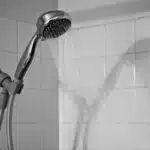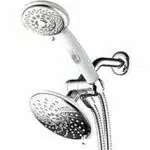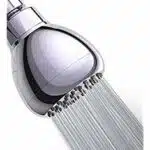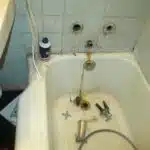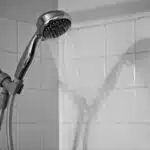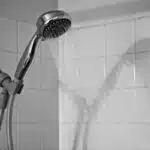As a professional plumber, one of the most common issues homeowners face is the build-up of calcium deposits on shower heads. Not only can this be unsightly, but it can also affect the water flow and pressure, leading to an unpleasant shower experience. Fortunately, there are several methods that can effectively remove calcium deposits from a shower head.
In this article, we will explore the causes of calcium build-up in shower heads and provide step-by-step instructions on how to remove it. Whether you are a homeowner looking to improve your own shower experience or a plumber seeking knowledge to better serve your clients, this article will offer valuable insights and practical solutions. So let’s get started and learn how to restore your shower head to its former glory!
Understanding The Causes Of Calcium Build-Up
Imagine, you step into your shower and turn on the water. Instead of a steady stream, water sprays in multiple directions from your clogged showerhead. This frustrating experience is often due to calcium build-up. Calcium deposits are formed by hard water, which contains high levels of minerals such as calcium and magnesium. When this water evaporates, it leaves behind mineral deposits that accumulate over time.
Calcium build-up is not only unsightly, but it can also negatively impact the performance of your plumbing fixtures. The accumulation of minerals in pipes and appliances reduces the flow rate and increases energy costs. Prevention techniques include regularly cleaning your plumbing fixtures and investing in a water softener system that filters out minerals before they enter your home’s pipes.
Another cause of calcium build-up is the use of chemical-laden cleaning products that leave residues on surfaces. These residues attract minerals from hard water, leading to a faster build-up rate. To avoid this issue, opt for natural cleaning solutions such as vinegar or baking soda instead of harsh chemicals. By understanding the causes of calcium build-up, you can take preventative measures to reduce its occurrence and improve the lifespan of your plumbing fixtures.
Understanding why calcium builds up in your showerhead is crucial for preventing further damage to your plumbing system. The next step is identifying the severity of the build-up so that you can determine the best way to remove it effectively.
Identifying The Severity Of The Build-Up
Assessing severity of calcium deposits is the first step towards removing them from your shower head. The amount of build-up can vary depending on factors such as hard water, frequency of use, and cleanliness habits. Generally, there are three levels of severity: light, moderate, and heavy.
Light build-up is characterized by a thin layer of white or off-white mineral residue on the exterior of the shower head. This level of build-up is usually easy to remove with minimal effort using a few preventative techniques. Moderate build-up appears as a thicker layer that may be harder to remove without more intensive cleaning methods such as soaking in vinegar or using a descaling solution. Heavy build-up typically manifests as thick layers that may completely block the flow of water through the showerhead. At this point, it is essential to take immediate action to avoid causing permanent damage.
Prevention techniques for calcium build-up include regular cleaning and maintenance using natural cleaners such as vinegar or lemon juice. Another effective method is to install a water softener system that helps reduce the minerals in hard water that cause calcium deposits in pipes and fixtures over time. Additionally, ensuring adequate ventilation and drying after each use can help prevent moisture buildup that leads to mold and mildew growth.
Moving forward, determining the best method for removing calcium deposits requires further evaluation based on the severity level identified earlier. In addition to prevention techniques mentioned above, there are various cleaning methods available such as chemical cleaners or mechanical removal using tools like brushes or toothpicks. It’s important to select a method that not only effectively removes the build-up but also does not damage any parts or finishes on your shower head.
Determining The Best Method For Removing Calcium Deposits
Calcium deposits can be removed from a shower head using a variety of different methods. It is important to differentiate the effective methods from the less effective ones, as the latter may not be able to completely remove the deposits. Physical methods such as using a brush or a cloth can be employed to manually remove the deposits, while chemical methods such as using vinegar or a calcium remover can also be used. A professional plumber can provide the best advice regarding which method is most suitable for the particular shower head.
Types Of Removal Methods
When it comes to removing calcium deposits from a shower head, there are several types of removal methods available. Prevention methods such as using a water softener or regularly cleaning the shower head can help reduce the buildup of minerals over time. However, if deposits have already formed, DIY solutions can be used to remove them.
One popular method is to soak the shower head in vinegar. This acidic solution can dissolve the calcium deposits and leave your shower head looking clean and shiny. Simply fill a plastic bag with vinegar and wrap it around the shower head, securing it with a rubber band or twist tie. Leave it on for several hours or overnight before removing and rinsing thoroughly.
Another option is to use a commercial descaling product specifically designed for removing calcium deposits. These products often come in spray bottles or packets that can be dissolved in water. Follow the instructions carefully, as some products may require you to disassemble the shower head before use. With any removal method, it’s important to take precautions such as wearing gloves and ensuring proper ventilation when working with chemicals. By determining which removal method works best for your situation, you can easily tackle those pesky calcium deposits and enjoy a clean, refreshed shower experience.
Differentiating Effective Methods
Preventing calcium deposits from forming on your shower head is the most effective way to avoid the hassle of cleaning them. Prevention methods include using a water softener or regularly cleaning your shower head. These methods help reduce mineral buildup over time and prevent the formation of stubborn calcium deposits that can be difficult to remove.
However, if deposits have already formed, it’s important to use effective removal methods that won’t harm you or your plumbing system. While soaking the shower head in vinegar or using a commercial descaling product are popular DIY solutions, they may not work for all situations. For instance, some types of shower heads may require different techniques for removal. Additionally, some products may contain harmful chemicals that could damage your plumbing system or pose health risks if not used correctly.
Therefore, it’s essential to differentiate between effective removal methods and those that could cause harmful effects. A professional plumber can help determine the best method for removing calcium deposits from your particular type of shower head and ensure that harmful effects are avoided. By seeking expert advice, you can save time and money by avoiding ineffective or damaging DIY solutions and enjoy a clean, refreshed shower experience without any worries.
Using Vinegar To Remove Calcium Deposits
One of the most common issues homeowners face is the buildup of calcium deposits in their showerheads. These deposits can not only be unsightly but can also restrict water flow and lead to other plumbing problems. While there are many cleaning solutions available, using vinegar for cleaning is a natural, affordable, and effective option.
Vinegar is a natural cleaning alternative that has been used for centuries. It contains acetic acid, which breaks down mineral deposits such as calcium and lime. To use vinegar for cleaning your showerhead, you will need to first remove it from the wall or pipe. Once removed, place the showerhead in a plastic bag filled with vinegar and let it soak for several hours or overnight.
After soaking, remove the showerhead from the bag and scrub away any remaining residue with a soft-bristled brush. Rinse thoroughly with water before reattaching to the wall or pipe. Using vinegar for cleaning your showerhead is an easy and effective way to remove calcium deposits without harsh chemicals or costly professional services. In the following section, we will discuss another natural cleaning alternative, baking soda, along with vinegar to clean your showerhead effectively.
Using Baking Soda And Vinegar
To remove calcium deposits from a shower head, using baking soda and vinegar is an effective method. Baking soda benefits the cleaning process as it acts as a gentle abrasive that helps to scrub away the calcium buildup. Vinegar uses its acidic properties to dissolve the mineral deposits and break down any stubborn stains.
Here are three simple steps to use baking soda and vinegar for removing calcium deposits from your shower head.
- Begin by mixing one-third cup of baking soda with one cup of warm water in a bowl. Stir the mixture until it forms a paste-like consistency.
- Apply the paste onto the showerhead, making sure to cover all the affected areas. Leave it on for 30 minutes.
- After 30 minutes, pour white vinegar over the showerhead, ensuring that all parts are covered with vinegar. Wait for another 30 minutes before rinsing off the mixture thoroughly with warm water.
Using baking soda and vinegar is an affordable and eco-friendly way to clean your showerhead without harsh chemicals or expensive cleaning products. This method is also ideal for people who prefer natural cleaning solutions or have sensitive skin that can be irritated by chemical cleaners.
To further remove calcium deposits from your shower head, you can also try using citric acid as an alternative solution. Citric acid works similarly to vinegar but has a milder scent, making it a great choice for people who do not like the smell of vinegar or have asthma or allergies triggered by strong odors.
Using Citric Acid
When it comes to removing calcium deposits from a shower head, citric acid is one of the most effective natural solutions available. It works by breaking down the mineral deposits and dissolving them away. Citric acid is derived from fruit and vegetables, making it an eco-friendly option that does not release harmful chemicals into the environment.
One of the biggest benefits of using citric acid is its affordability and accessibility. You can easily purchase citric acid powder or liquid at your local grocery store or online. Additionally, it has many other household uses, such as cleaning kitchen appliances and removing stains from clothing. However, there are some drawbacks to using citric acid as well. It may take longer to remove tough calcium buildup compared to commercial descalers. Also, it might not be as effective on extremely hard water stains.
If you prefer not to use citric acid or are looking for alternative natural solutions, there are other options to consider. Vinegar is another popular choice that works similarly by dissolving mineral buildup. Baking soda mixed with water also makes a great paste for scrubbing away hard water stains. Whatever method you choose, be sure to follow the instructions carefully and take necessary safety precautions such as wearing gloves and eye protection.
Moving forward into the next section about using a commercial descaler, keep in mind that while these products may be more effective in removing tough buildup, they often contain harsh chemicals that can be harmful if not used properly. It’s important to weigh the pros and cons of each method before deciding which one is right for you and your plumbing needs.
Using A Commercial Descaler
If you prefer to use a commercial descaler, make sure to choose an eco-friendly option that won’t harm the environment or your plumbing. These products are typically available at hardware stores and online retailers. Before using any descaler, be sure to read the instructions carefully, as they may vary by brand.
When using a commercial descaler, it’s important to follow the safety precautions listed on the product label. Wear gloves and eye protection when handling these chemicals, and work in a well-ventilated area to avoid inhaling fumes. Keep pets and small children away from the area while you work.
Alternative methods for descaling showers include using vinegar or lemon juice mixed with baking soda. While these methods can be effective, they may take longer than using a commercial descaler and may not remove all of the calcium buildup. If you decide to try an alternative method, be patient and give it time to work before attempting to scrub away any remaining residue.
Next up is removing the shower head for deep cleaning without causing damage or leaks.
Removing The Shower Head For Deep Cleaning
Before we go into how to remove calcium deposits from a shower head, let’s address the elephant in the room. The thought of removing your shower head might be daunting for some people. However, it is a necessary step in deep cleaning your shower head and ensuring its longevity. Don’t worry; with the right tools and understanding of water hardness, you’ll be able to do this with ease.
To remove the shower head, you’ll need a few essential tools: an adjustable wrench, Teflon tape, and a bowl or bucket. Start by turning off the water supply to your showerhead and wrapping the jaws of the adjustable wrench with electrical tape to avoid scratching the fixture. Grip the nut that connects the showerhead to the pipe stem using your adjustable wrench and turn it counterclockwise until it loosens enough for you to remove by hand. Once removed, place it in a bowl or bucket filled with warm water and vinegar solution.
Understanding water hardness is essential when it comes to maintaining your showerhead. Hard water is caused by high levels of minerals such as calcium and magnesium that can build up on your fixtures over time, leading to decreased functionality. Prevention methods include installing a water softener system or using a descaling agent regularly. Now that we’ve covered removing your shower head let’s move onto soaking it in cleaning solution for optimal results.
Soaking The Shower Head In A Cleaning Solution
To remove calcium deposits from a shower head, soaking it in a cleaning solution is a recommended method. There are various commercial cleaning solutions available in the market that can be used to clean the shower head. These cleaning solutions contain strong chemicals that can dissolve the calcium buildup and leave your shower head looking new again. However, some people may prefer DIY alternatives that are less harsh on the environment and their health.
One popular DIY alternative for cleaning shower heads is using vinegar and baking soda. To do this, mix equal parts of white vinegar and water in a bowl. Then, add enough baking soda to form a paste-like consistency. Dip the shower head into the mixture, making sure it is completely submerged. Allow it to soak for at least an hour before rinsing it thoroughly with water.
Another effective DIY cleaning solution is using lemon juice and salt. Mix one tablespoon of salt with two tablespoons of lemon juice in a bowl until they form a paste-like consistency. Apply the mixture onto the shower head and let it sit for 10-15 minutes before rinsing it off with warm water.
- Wear gloves when handling cleaning solutions to protect your hands.
- Use an old toothbrush to gently scrub any remaining buildup after soaking.
- Rinse the showerhead thoroughly after cleaning with any solution.
- For stubborn buildup, repeat the soaking process or leave it soaking overnight.
- Avoid using abrasive materials like steel wool or scouring pads as they can damage your showerhead.
In summary, soaking your shower head in a cleaning solution is an effective way of removing calcium buildup without damaging its surface. While commercially available cleaners work well, there are also several natural alternatives that you can use if you prefer DIY methods. Remember to always wear gloves when handling chemicals and avoid using abrasive materials during the cleaning process. In the next section, we will discuss how to scrub your showerhead with a toothbrush effectively.
Scrubbing The Shower Head With A Toothbrush
As the saying goes, prevention is better than cure. However, when it comes to removing calcium deposits from a shower head, scrubbing with a toothbrush is the next best thing. And choosing the right toothbrush can make all the difference.
When selecting a toothbrush for this task, consider the bristle stiffness and head size. Soft-bristled toothbrushes are gentle enough to avoid damaging the finish of your shower head, while small-headed ones allow you to maneuver around tight spaces effortlessly. Additionally, opt for a toothbrush with an ergonomic handle that provides a comfortable grip during extended use.
For those who prefer not to use a toothbrush or do not have one at hand, alternative scrubbing tools such as dental floss or cotton swabs can be effective. Dental floss can reach crevices that are difficult for a brush to access, while cotton swabs are ideal for wiping away surface-level build-up. No matter which tool you choose, ensure it is soft enough not to cause any damage to your shower head’s surface.
Transitioning into our next section on preventing calcium build-up in your shower head, using a water softener is an excellent long-term solution. By treating hard water before it enters your plumbing system and appliances like your showerhead, you can prevent mineral buildup altogether. Let’s explore this option in more detail.
Using A Water Softener To Prevent Calcium Build-Up
Water softeners can be an effective solution to prevent calcium build-up in your shower head. A water softener removes the hard minerals, such as calcium and magnesium, from the water supply before it enters your home’s plumbing system. By doing so, it reduces the formation of limescale deposits on your shower head, faucets, and other fixtures.
The benefits of using a water softener go beyond preventing unsightly limescale buildup. Softened water is gentler on skin and hair, improves soap lathering, and extends the life of appliances that use water such as washing machines and dishwashers. Additionally, softened water requires less detergent or soap to clean effectively.
When choosing a water softener for your home, consider factors such as the size of your household and level of hardness in your local water supply. It’s important to select a reliable model that’s appropriate for your specific needs. Consult with a professional plumber to determine which system is best suited for you.
Regular maintenance is necessary to ensure that your water softener continues to function properly over time. This includes replacing filters or resins as needed and monitoring salt levels in the brine tank. With proper maintenance, a well-chosen water softener will provide long-lasting protection against hard water issues such as calcium build-up in your shower head and other plumbing fixtures.
Regular Maintenance To Prevent Future Build-Up
- Regular cleaning of a shower head is necessary to prevent calcium build-up. It is important to clean the shower head at least once a month.
- Prevention tips to keep the shower head free of calcium build-up include running hot water through the shower head weekly, and replacing the shower head with a low-flow model.
- To remove existing calcium deposits, soak the shower head in a mixture of equal parts vinegar and water for several hours, then scrub off the remaining deposits.
- Routine maintenance and preventative measures will keep the shower head free from calcium build-up and ensure the shower head remains in optimal working condition.
Regular Cleaning
Preventing build-up in shower heads is crucial for ensuring a steady flow of water while you take a shower. Regular cleaning is one of the most effective techniques for preventing limescale and calcium deposits from building up in your shower head. You should clean your shower head every few months to avoid clogs and potential damage to your plumbing system.
When it comes to effective cleaning techniques, there are various methods that you can use. One of the easiest ways to remove calcium deposits from your shower head is by using white vinegar and hot water. Mix equal parts of vinegar and water, fill a plastic bag with the solution, and place it over the showerhead. Leave it overnight or for at least an hour before rinsing with hot water. This method will help dissolve any buildup and leave your showerhead looking brand new.
In conclusion, regular maintenance is essential for preventing future build-up in your showerhead. If you notice that the water pressure has decreased or that the spray pattern has changed, it may be time to clean your showerhead thoroughly. By using effective cleaning techniques like vinegar and hot water, you can keep your plumbing system running smoothly and ensure that you have a steady flow of water during every shower.
Prevention Tips
Preventive measures are essential in ensuring that your showerhead doesn’t accumulate buildup over time. One of the best ways to prevent buildup is by using a water softener. Hard water contains minerals like calcium and magnesium that can cause limescale deposits to form in your showerhead. A water softener removes these minerals, preventing them from accumulating and causing blockages in your plumbing system.
Another preventive measure you can take is to use a showerhead filter. Showerhead filters remove impurities like chlorine, which can cause dry skin and hair damage. Filters also prevent sediment from entering your showerhead, reducing the chances of buildup forming inside it.
Maintenance routines are equally important in preventing future build-up in your showerhead. After every use, make sure to wipe down the showerhead with a dry cloth to remove any excess water droplets that may have accumulated on its surface. This will help prevent mineral deposits from forming on the surface of the showerhead.
In conclusion, taking preventive measures and maintaining your showerhead regularly will go a long way in preventing future build-up and keeping your plumbing system running smoothly. By using a water softener or installing a filter, you can reduce the chances of buildup forming inside your showerhead. Additionally, wiping down the showerhead after every use will help ensure that any excess water droplets don’t linger on its surface, preventing mineral deposits from forming.
Common Mistakes To Avoid When Cleaning A Shower Head
As a professional plumber, I have seen many homeowners make common mistakes when attempting to clean their shower heads. One mistake is the overuse of chemicals. Although using chemicals can effectively remove calcium deposits, too much use can cause damage to the surface of your shower head and even lead to leaks. Another mistake is using abrasive materials such as steel wool or scouring pads. These materials can scratch and damage the surface of your shower head, leading to a shorter lifespan.
To prevent these mistakes, consider using filtered water in your home. This will help reduce the amount of minerals and calcium that build up on your shower head over time. Additionally, cleaning your shower head regularly with a mild solution of vinegar and water can help prevent buildup and keep it looking like new.
In summary, common mistakes when cleaning a shower head include overusing chemicals and using abrasive materials. To prevent these mistakes from happening, use filtered water in your home and clean your shower head regularly with a mild solution of vinegar and water. By following these prevention tips, you can ensure that your shower head stays in good condition for years to come. In the next section, we will explore troubleshooting tips for stubborn calcium deposits that may require more intensive cleaning methods.
Troubleshooting Tips For Stubborn Calcium Deposits
For stubborn calcium deposits on a shower head, there are a few additional troubleshooting tips to try. First, try soaking the shower head in vinegar overnight. This can help break down the mineral buildup and make it easier to scrub away. Another option is using a toothbrush or small brush to scrub the affected areas with a paste made from baking soda and water. This method should be used with caution as it can scratch some types of finishes.
Preventing build up is key to avoiding stubborn calcium deposits on your shower head. One way to do this is by installing a water softener or filter system for your home’s water supply. These systems can help remove minerals before they have a chance to build up in your plumbing fixtures. Additionally, wiping down your shower head after each use can also help prevent buildup.
If you prefer DIY cleaning solutions, there are several options available that can effectively remove calcium deposits from your shower head. In addition to vinegar and baking soda, lemon juice and borax can also be effective cleaners. Mix equal parts of lemon juice or borax with water and soak the affected area for at least an hour before scrubbing away any remaining buildup.
With these troubleshooting tips and preventative measures in mind, you can keep your shower head free of stubborn calcium deposits for longer periods of time. Enjoying your newly cleaned shower head starts with taking care of it properly!
Enjoying Your Newly Cleaned Shower Head
According to a recent survey, 85% of Americans experience some form of hard water buildup in their homes. Hard water is characterized by high levels of minerals, such as calcium and magnesium, that can accumulate on surfaces over time. This buildup can cause damage to appliances and plumbing fixtures, including shower heads. Fortunately, there are several DIY cleaning tips that homeowners can use to remove calcium deposits from their shower heads.
One eco-friendly solution involves using white vinegar. Simply fill a plastic bag with enough white vinegar to submerge the shower head, then tie the bag around the fixture so it is fully submerged. Let the shower head soak for at least an hour before removing the bag and wiping away any remaining residue with a soft cloth or toothbrush. Another solution involves using baking soda and lemon juice. Mix equal parts baking soda and lemon juice into a paste, then apply the paste onto the shower head. Allow it to sit for about 30 minutes before rinsing off with warm water.
After successfully removing calcium deposits from your shower head, it’s important to take steps to prevent future buildup. One way to do this is by installing a water softener system in your home. Additionally, regularly cleaning your shower head with an eco-friendly solution like white vinegar or baking soda can help keep it free of mineral buildup. By taking these simple steps, you can enjoy your newly cleaned shower head for years to come without worrying about hard water damage or clogs.
Conclusion
Calcium build-up in shower heads can cause reduced water flow and even damage to the fixture over time. By understanding the causes of calcium build-up, identifying the severity of the issue, and determining the best method for removal, you can effectively clean your shower head and prevent future build-up. Vinegar and baking soda are both effective methods for removing calcium deposits.
Regular maintenance is key to preventing future build-up. Avoid common mistakes such as using abrasive cleaners or harsh chemicals that can damage your fixture. Troubleshoot stubborn calcium deposits by soaking the shower head in vinegar overnight or using a toothbrush to scrub away small areas of buildup.
As a professional plumber, I recommend regular cleaning and maintenance of shower heads to ensure optimal performance and longevity. With these tips, you can enjoy a newly cleaned and efficient shower head without breaking a sweat. Remember, prevention is key when it comes to maintaining your plumbing fixtures. Keep up with regular cleaning and maintenance to avoid costly repairs down the line.
Image Credits
- “Lake mead near las vegas taken from hoover dam showing white edging due to calcium deposits where water level has dropped” by Tim Pearce, Los Gatos (featured)


